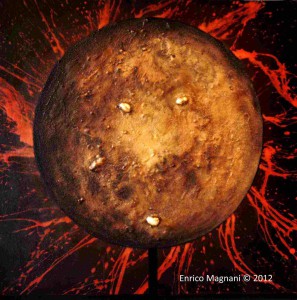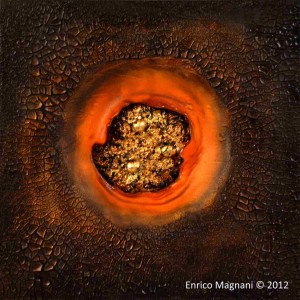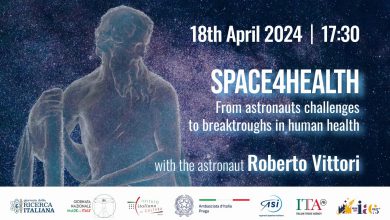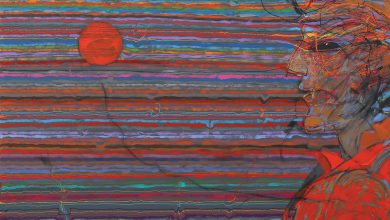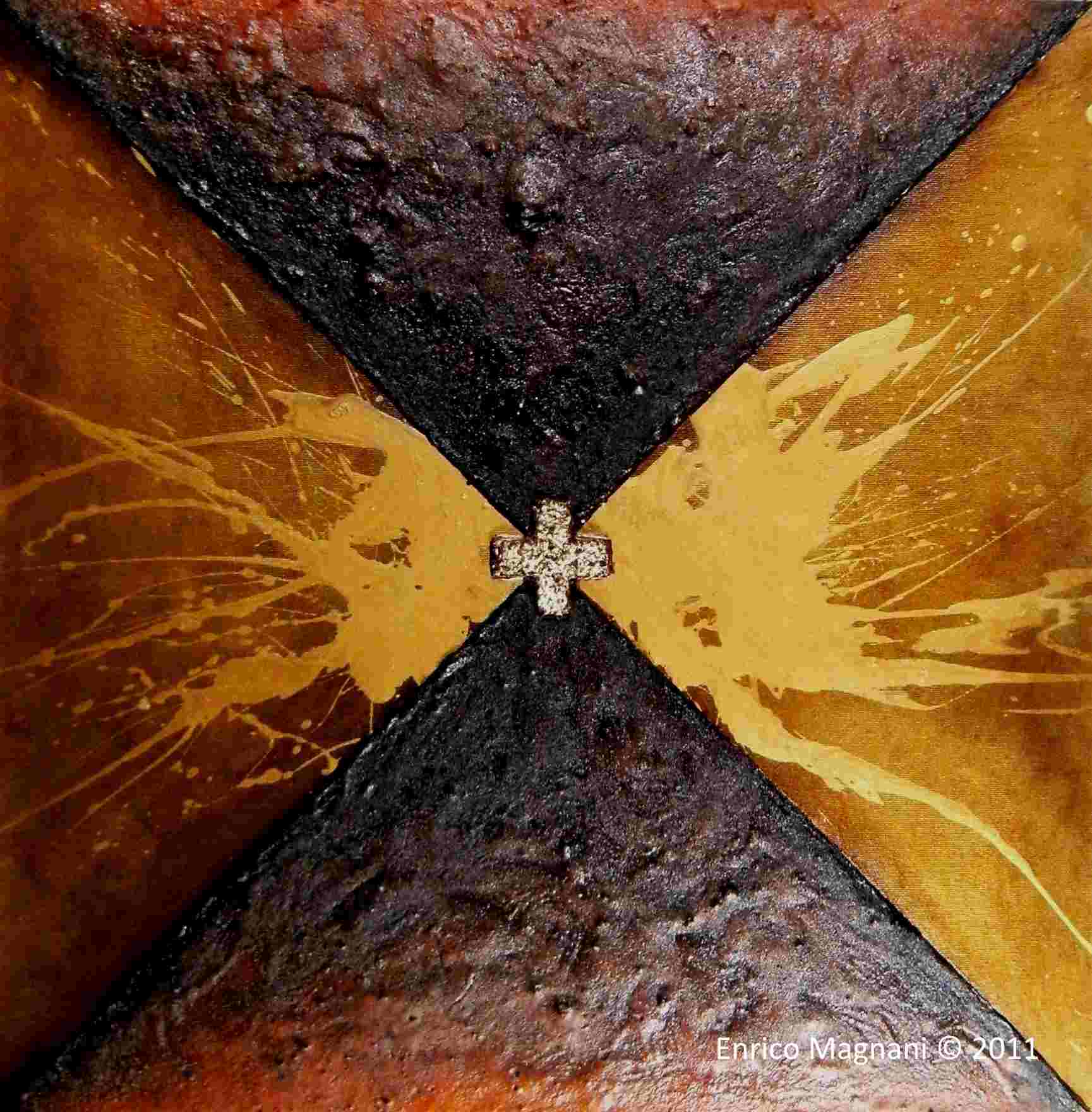
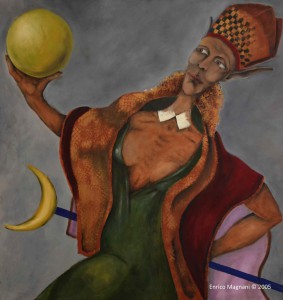 During recent years many researchers have highlighted the close relationship between modern art and esoterism; and more generally they have shown that mysticism and esotericism thought are specific characteristics of an important part of modern and contemporary culture. If, at first sight, these conclusions may appear paradoxical, in a society based on rational and mechanistic principles dwelling in a very advanced state of secularization, at a deeper level of analysis it is rather evident that a considerable part of modern culture has, in its essence, an important component of what is often inaccurately called “irrationalism” and mysticism.
During recent years many researchers have highlighted the close relationship between modern art and esoterism; and more generally they have shown that mysticism and esotericism thought are specific characteristics of an important part of modern and contemporary culture. If, at first sight, these conclusions may appear paradoxical, in a society based on rational and mechanistic principles dwelling in a very advanced state of secularization, at a deeper level of analysis it is rather evident that a considerable part of modern culture has, in its essence, an important component of what is often inaccurately called “irrationalism” and mysticism.
It is known that many artists of the avant-garde, but not only, at the turn of the nineteenth and twentieth century were captured by the charm of the occult. It is enough to mention the theosophical interests of Kandinsky and Mondrian; the occult inclinations of the Futurist painters and writers, the Corradini brothers; the Dadaist and esotericist Julius Evola … These are all examples that demonstrate how modern art, characterized by a more and more strong tendency towards abstraction and a declared hostility against every form of realism, has roots that not only go into irrationalism, but also in the secular esoteric tradition, part of the Western culture ever since.
Both considered key tools for understanding reality and inner investigation, art and esotericism go hand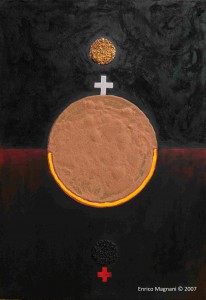 in hand since ancient times and, if the first has drawn from the esoteric tradition its themes and motives, the esoteric culture, at the same time, has found in art one of the forms – if not the form par excellence – of privileged expression to convey inside the society teachings considered initiatic and symbols that give evidence of the vitality in all times and places of the world.
in hand since ancient times and, if the first has drawn from the esoteric tradition its themes and motives, the esoteric culture, at the same time, has found in art one of the forms – if not the form par excellence – of privileged expression to convey inside the society teachings considered initiatic and symbols that give evidence of the vitality in all times and places of the world.
Enrico Magnani, nuclear physicist (therefore, first of all, researcher about matter), has felt at some point of his research the need to use art to proceed in those narrow paths of knowledge where the purely rational speculation is not enough, and the necessity to draw from the emotion, from that intuition that is not irrational, but “otherwise rational” that only art, at a certain level of development, can express in its language that goes beyond the limits of logic and positive thought.
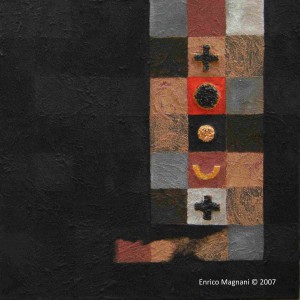 The artistic research of Enrico Magnani implies a mystical-occultist conception of reality, and the clearly discernible presence of the symbols of the tradition in his works is not ancillary, or the result of a style that the artist has joined, but a necessary emotional modality in order to achieve a higher state of consciousness and, consequently, a higher level of knowledge, as well as the only way to transmit it to those people who are ready to understand these symbols.
The artistic research of Enrico Magnani implies a mystical-occultist conception of reality, and the clearly discernible presence of the symbols of the tradition in his works is not ancillary, or the result of a style that the artist has joined, but a necessary emotional modality in order to achieve a higher state of consciousness and, consequently, a higher level of knowledge, as well as the only way to transmit it to those people who are ready to understand these symbols.
The artistic research of Magnani is often compared to alchemy in painting, a transposition of the work of the ancient alchemists (that in its practical step was not that different from what nuclear physicists are doing today) from the Athanor to the painter’s canvas. This is certainly right, but what would be the “Philosopher’s Gold” to which the artist aspires? Are the elixir of life and the fulfillment of the Great Work reached through the combination of the elements and the colors in a painting or modelling the matter in a sculpture?
This “Gold of the Philosophers”, and the ultimate goal of Magnani’s research, is achieving what some have called “objective art”.
Art, for Magnani, is a way of knowledge, and so it is science. It, as way of knowledge, reveals mysteries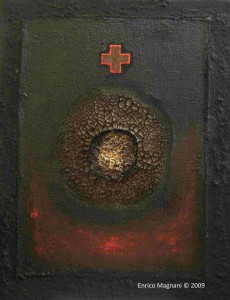 and is necessarily related with the domain of the unknown, with what still eludes the limited understanding that, in the ordinary state, the human being has about the universe. Far from being imitative, the art of Magnani tends to go beyond the mechanical reproduction of nature, or the solipsistic representation of interiority of the artist. He, with an awakened work and conscious of the deep connections between micro and macrocosm, between man and universe, aspires to achieve in his work that “something” that is difficult to describe in words, and that was common to great works of art in the remote times, and of which there is no more trace in any of the contemporary artworks. The art of Enrico Magnani tends to overcome the subjectivity of the artist, the subjectivity typical of our contemporary culture in which the artist perceives a subjective feeling and tries to express it through the use of subjective forms; and at the same time, he wants to go even beyond the subjectivity of the viewer, that is, beyond the individual perception that viewers have in front of these forms.
and is necessarily related with the domain of the unknown, with what still eludes the limited understanding that, in the ordinary state, the human being has about the universe. Far from being imitative, the art of Magnani tends to go beyond the mechanical reproduction of nature, or the solipsistic representation of interiority of the artist. He, with an awakened work and conscious of the deep connections between micro and macrocosm, between man and universe, aspires to achieve in his work that “something” that is difficult to describe in words, and that was common to great works of art in the remote times, and of which there is no more trace in any of the contemporary artworks. The art of Enrico Magnani tends to overcome the subjectivity of the artist, the subjectivity typical of our contemporary culture in which the artist perceives a subjective feeling and tries to express it through the use of subjective forms; and at the same time, he wants to go even beyond the subjectivity of the viewer, that is, beyond the individual perception that viewers have in front of these forms.
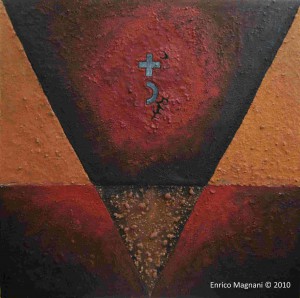 The artistic aim of Magnani is the overcoming of that level of art in which everything is arbitrary and accidental; everything is based on the associations and the impressions of the artist, perceived subjectively by individual viewers. In this subjective art, typical of the contemporary art, everything depends on the associative processes between the artist and the viewer and, therefore, the result is relative, that is, depending on these different associations made by each. Everything is accidental, the artist does not create consciously, but mechanically, and he is overwhelmed by ideas, thoughts, and moods that he himself does not fully understand and over which he does not have the least control.
The artistic aim of Magnani is the overcoming of that level of art in which everything is arbitrary and accidental; everything is based on the associations and the impressions of the artist, perceived subjectively by individual viewers. In this subjective art, typical of the contemporary art, everything depends on the associative processes between the artist and the viewer and, therefore, the result is relative, that is, depending on these different associations made by each. Everything is accidental, the artist does not create consciously, but mechanically, and he is overwhelmed by ideas, thoughts, and moods that he himself does not fully understand and over which he does not have the least control.
Magnani tends and aspires to make another kind of art, a kind of art that has the features, as we said, of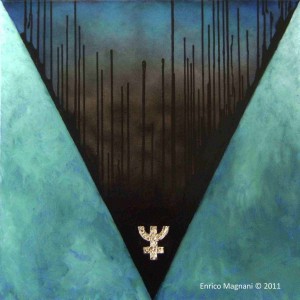 some ancient art; an art that is fully conscious creation, the result of a higher level of being and consciousness, capable of opening the doors of a not ordinary knowledge. Magnani himself says that his artworks “are always thought consciously, and also those elements linked to the case as the dripping, the thrown colour or the cracks (which break where they like, randomly), are always the result of a choice-related compositional context: for example the need of chaos as well as the need of the red colour or of a symbol in a certain precise place of the composition. Even the case, then, is included as a part of a higher project”.
some ancient art; an art that is fully conscious creation, the result of a higher level of being and consciousness, capable of opening the doors of a not ordinary knowledge. Magnani himself says that his artworks “are always thought consciously, and also those elements linked to the case as the dripping, the thrown colour or the cracks (which break where they like, randomly), are always the result of a choice-related compositional context: for example the need of chaos as well as the need of the red colour or of a symbol in a certain precise place of the composition. Even the case, then, is included as a part of a higher project”.
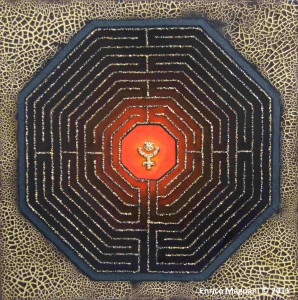 In this objective art that Magnani wants to achieve, nothing is truly accidental, everything is wanted, everything can be defined, and the painter is fully conscious of the message his work wants to communicate, a message that will always produce the same impression with rigorous certainty in all those people who are able to understand it. This art is addressed to the emotion of the human being, higher emotion, not the ordinary one, and not only to its purely rational sphere. The understanding of this art must be an “emotional understanding”. This type of “conscious art” has, as a goal, the enhancement of the knowledge through an emotional understanding of it. This art is able to convey emotions, ideas, and truth through the universal language of symbols, archetypes of a superior knowledge, perhaps inheritance of a lost age or perhaps the seed of a human potential lying asleep somewhere, asleep in that charming maze still largely unknown which is the human mind.
In this objective art that Magnani wants to achieve, nothing is truly accidental, everything is wanted, everything can be defined, and the painter is fully conscious of the message his work wants to communicate, a message that will always produce the same impression with rigorous certainty in all those people who are able to understand it. This art is addressed to the emotion of the human being, higher emotion, not the ordinary one, and not only to its purely rational sphere. The understanding of this art must be an “emotional understanding”. This type of “conscious art” has, as a goal, the enhancement of the knowledge through an emotional understanding of it. This art is able to convey emotions, ideas, and truth through the universal language of symbols, archetypes of a superior knowledge, perhaps inheritance of a lost age or perhaps the seed of a human potential lying asleep somewhere, asleep in that charming maze still largely unknown which is the human mind.

